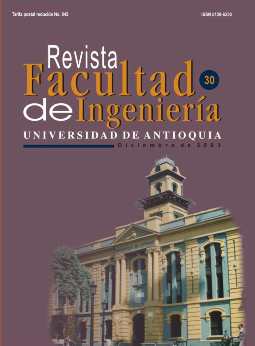Producción de frío a partir de campos magnéticos. Parte 2: Análisis termodinámico
DOI:
https://doi.org/10.17533/udea.redin.327314Palabras clave:
refrigeración magnética, ciclo de refrigeración, trabajo magnéticoResumen
En la refrigeración magnética se emplea un material magnético, el cual experimenta cambios de temperatura o intercambios de calor con los alrededores cuando se somete a un campo magnético intenso.
En este artículo se analiza un ciclo convencional de refrigeración magnética. Se obtienen expresiones para el calor liberado y absorbido y los cambios de temperaturas en las diferentes etapas del ciclo partiendo de la primera ley de la termo-dinámica. Así mismo, con el empleo de la segunda ley de la termodinámica, se obtienen ecuaciones para el trabajo consumido, el cambio de entropía y el coeficiente ideal de operación del ciclo en función de las temperaturas y de propiedades del material magnético.
Descargas
Citas
Velásquez, Juan E. et al. “Producción de frío a partir de campos magnéticos. Parte I: Conceptos Básicos”. En: Revista Facultad de Ingeniería. No. 29. 2003.
Karsjen, Steve. “Magnetic Refrigeration Makes a Cool Debut”. En: Advanced Materials & Processes. Vol. 152. Jul., 1997.
Wu, Corina. “Magnetic Materials Keep Fridges Cool”. En: News. Vol. 153. No. 123. Mar, 1998. DOI: https://doi.org/10.2307/4010285
Asimov, Isaac. Cronología de los Descubrimientos. Bar-celona. Ariel. 1997. p. 600, 635.
American Institute of Physics Handbook. New York. McGraw-Hill. 1957.
Descargas
Publicado
Cómo citar
Número
Sección
Licencia
Los artículos disponibles en la Revista Facultad de Ingeniería, Universidad de Antioquia están bajo la licencia Creative Commons Attribution BY-NC-SA 4.0.
Eres libre de:
Compartir — copiar y redistribuir el material en cualquier medio o formato
Adaptar : remezclar, transformar y construir sobre el material.
Bajo los siguientes términos:
Reconocimiento : debe otorgar el crédito correspondiente , proporcionar un enlace a la licencia e indicar si se realizaron cambios . Puede hacerlo de cualquier manera razonable, pero no de ninguna manera que sugiera que el licenciante lo respalda a usted o su uso.
No comercial : no puede utilizar el material con fines comerciales .
Compartir igual : si remezcla, transforma o construye a partir del material, debe distribuir sus contribuciones bajo la misma licencia que el original.
El material publicado por la revista puede ser distribuido, copiado y exhibido por terceros si se dan los respectivos créditos a la revista, sin ningún costo. No se puede obtener ningún beneficio comercial y las obras derivadas tienen que estar bajo los mismos términos de licencia que el trabajo original.










 Twitter
Twitter